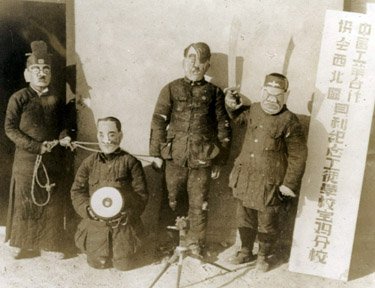Background on Indusco Bailie School

Bailie Technical School boys with masks
Following the Japanese invasion of China in 1937, the New Zealand expatriate Rewi Alley threw his considerable talents behind the war effort. Having lived and worked in China almost continuously for a decade, Alley was intimately familiar with the country, well-traveled, and well connected, including to Mao Zedong and the Communist underground.
After witnessing first-hand the devastation of the Japanese assault in Shanghai, Alley gathered a group of eleven like-minded friends at a local restaurant in April 1938 to help organize and support the resistance. The result of that meeting was the formation of the Chinese Industrial Cooperative Movement (CIC), also known as the Gung Ho Movement from the Chinese slogan for "work together." From the outset, the CIC was an ambitious enterprise built upon the chaos of war and, at least initially, it drew support from both Communists and Nationalists. The plan was to establish a network of industrial cooperatives throughout the unoccupied regions of the country, away from the vulnerable coastal cities, mobilizing labor from among the large pool of refugees to produce everything from vehicles to armaments, machinery, clothing, and other durable goods needed for the war effort. With the blessing of the British and Chinese governments, Alley arranged to have factories freighted inland to keep production flowing, engaging the Chinese workers in the gung ho spirit to do the work themselves. To fund the movement, in 1939, Alley's energetic associate Ida Pruitt created Indusco, Inc., as a New York-based fundraising arm of the CIC.
Alley expanded his efforts by founding a series of industrial schools named in honor of his friend, Joseph Bailie, an American missionary. Beginning in 1942 with a school in Shuangshipu, Shaanxi Province, the Bailie Schools proliferated, taking in orphans, refugees, and workers from the cooperatives to teach basic literacy and industrial skills and to build a sense of comradery and commitment to the gung ho ethos. When the Shuangshipu school was relocated in 1944 to Shandan, Gansu Province, to escape Nationalist pressure, Alley went along as headmaster.
The victory of Communist forces in 1949, left Alley's stock as a pro-Communist foreigner at relatively high ebb. Although he was displaced from his position as headmaster at Shandan when the school was reoriented to heavy industry in 1952, Alley remained in China, working as a writer and sometime propagandist for the Communist government. An advocate of international peace, he was a vocal critic of American intervention in Asia during the Korean and Vietnam Wars, and became recognized as one of the elite group of foreign "friends of China." Although he suffered a fall from privilege during the Cultural Revolution, Alley remained in China until his death on Dec. 27, 1987.
Alley's friend and CIC co-founder, Edgar Snow, considered Alley to have been as important to China during the Sino-Japanese War as T.E. Lawrence was to the Arabs during the First World War, "and perhaps more," symbols of active resistance, as much as agents of change. "Where Lawrence brought to Arabia the destructive techniques of guerrilla warfare," Snow wrote, "Alley is teaching China the constructive organisation of guerrilla industry."


![[Chinese boy with mallet] [Chinese boy with mallet]](http://credo.library.umass.edu/images/resize/200/mums564-b001-i002-001.jpg)
![[Chinese boys brushing teeth] [Chinese boys brushing teeth]](http://credo.library.umass.edu/images/resize/200/mums564-b001-i003-001.jpg)

![[Chinese boy and girl working with loom] [Chinese boy and girl working with loom]](http://credo.library.umass.edu/images/resize/200/mums564-b001-i005-001.jpg)


![[Bailie Technical School making masks] [Bailie Technical School making masks]](http://credo.library.umass.edu/images/resize/200/mums564-b001-i008-001.jpg)
![Bailie School in Chengdu [boy in uniform standing behind boy with rabbit] Bailie School in Chengdu [boy in uniform standing behind boy with rabbit]](http://credo.library.umass.edu/images/resize/200/mums564-b001-i009-001.jpg)
![Bailie School in Chengdu [five boys in uniform with Andrew Braid(?)] Bailie School in Chengdu [five boys in uniform with Andrew Braid(?)]](http://credo.library.umass.edu/images/resize/200/mums564-b001-i010-001.jpg)
![Bailie School in Chengdu [boys in uniform shaking hands] Bailie School in Chengdu [boys in uniform shaking hands]](http://credo.library.umass.edu/images/resize/200/mums564-b001-i011-001.jpg)
![[Bailie School in Chengdu: three boys in uniform with Rewi Alley(?)] [Bailie School in Chengdu: three boys in uniform with Rewi Alley(?)]](http://credo.library.umass.edu/images/resize/200/mums564-b001-i012-001.jpg)
![[Bailie School in Chengdu: group shot with students and instructors: Rewi Alley seated third from left, Andrew Braid fourth from left] [Bailie School in Chengdu: group shot with students and instructors: Rewi Alley seated third from left, Andrew Braid fourth from left]](http://credo.library.umass.edu/images/resize/200/mums564-b001-i013-001.jpg)
![Bailie School in Chengdu [boys in uniform pointing at artwork] Bailie School in Chengdu [boys in uniform pointing at artwork]](http://credo.library.umass.edu/images/resize/200/mums564-b001-i014-001.jpg)
![[Group standing around donkey cart, raising fists in celebration] [Group standing around donkey cart, raising fists in celebration]](http://credo.library.umass.edu/images/resize/200/mums564-b001-i016-001.jpg)

![Planting [illeg.] teazels Planting [illeg.] teazels](http://credo.library.umass.edu/images/resize/200/mums564-b001-i018-001.jpg)
